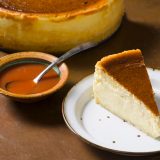It was a cool, dark morning in Xochimilco in southern Mexico City. We exited the van in a deserted parking lot patrolled by a pack of stray dogs and littered with garbage spilling out of too-small containers. We walked toward a canal and onto a long barge where I met Eduardo García, our guide and chef and owner of Maximo Bistrot. We were headed up to a chinampa (an island) where García cooked the simplest and best dish imaginable—Mexican beans flavored with a quick sofrito and salsa.
That evening, he invited us to his restaurant, which is a blend of French technique and local ingredients. The menu includes spinach spaghetti with sausage; risotto; a Wagyu flat iron steak; porcini soup; yellowfin tuna… More international than local, and a far cry from the chilaquiles sandwich (chicken cutlet with chilaquiles, crema and salsa) I’d had for breakfast the day before.
García is a terrific cook with a hard-scrabble beginning. He comes from a family of migrant workers and, at 5 years old, he started picking tomatoes here in the U.S. at 7 a.m. His work ethic has served him well.
His restaurant career started, as so many do, as a dishwasher who moved up to the salad station. He then worked at Brasserie Le Coze (a restaurant opened by Eric Ripert, of Le Bernardin). After roughly a decade in the U.S., García ended up on the wrong side of the law and was deported to Mexico with no chance of returning. In 2011, he started Maximo, where his 18-hour days are legendary. They also are, in part, responsible for his success. In July 2020, he opened in a new, much larger location (a long, airplane hangar space with a vaulted ceiling, wood tables and whitewashed walls) and now employs 120 people, which is part of his mission: providing a helping hand to others like himself.
All of this is to say that García is cooking what he likes to cook and, let’s be honest, this is the charm of the world of food—you rarely get what you expect. Why not the world’s best cheesecake at Maximo Bistrot?
Now for the obvious question: Why is this the world’s best? For starters, he calls for a triple crème cheese made from cow’s milk, along with cream cheese and heavy cream. Triple crème is widely available and, as it turns out, essential. (The rind has to be discarded, so we suggest purchasing 1¼ pounds to end up at the net 1 pound needed for the recipe.) We fiddled here and there, but the recipe was pretty much spot on the first time around: much lighter than it has a right to be, almost wet and creamy at the center, with a lightly toasted top crust. Perfect.
García serves the cheesecake with a guava sorbet and compote, a tropical foil. After tasting a number of guava products, we settled on using guava nectar, which is widely available in cans, aseptic packaging and also in the refrigerated section. The nectar is reduced in a skillet, then a sugar/salt/cornstarch mixture is whisked in. Off heat, lime juice is added and the sauce is chilled before serving.
So when you think Mexico, think cheesecake. You rarely get what you expect. And sometimes you get a whole lot more.







